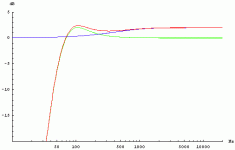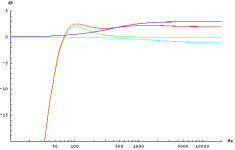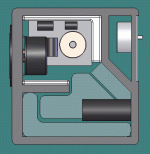Thanks for your thoughts, ruerose. The bass reflex tube however, is not easy to place elsewhere, but I guess it will help in this aspect if I make it so long that the magnet will effectively "shield it" from direct radiation, yet having enough air between them to ensure the air flow isn't hindered.. I can attach some damping material to the back of the magnet as well...
This is the first time I use Mathematica for speaker design, and I must say I really like working with it. Ofcourse you need to write all the equations by hand, but it's really cool to have the impedance as a graphed function to insert into filter equations, combining the resulting response with the response graph of the bass reflex cabinet, etc.. For a project involving more drivers, phase diagrams could be generated based on the crossover as well... All in all a great tool for designing speakers I think. 
Konnichiwa,
I do not know the CSS Drivers, but I know the JX92S and other smallish full range drivers....
I have recently build something that would seem to answer your description:
http://www.diyaudio.com/forums/showthread.php?s=&threadid=80846
They certainly handle a lot more SPL and LF than the Jordans and any of the other small Fr's I am familiar with, these manage well above average low frequency dynamics for such a small dinky thing, even by 5" woofer standards.
Sayonara
Rocky said:I have already had a good look on the Fostex F120A 5”, but they are a little on the expensive side. The candidates I'm considering seriously are Jordan JX92S and Fostex FX120 (love the appereance of this one), perhaps also the CSS FR125S. Any opinions on those drivers or others the same size for such an application?
I do not know the CSS Drivers, but I know the JX92S and other smallish full range drivers....
I have recently build something that would seem to answer your description:
http://www.diyaudio.com/forums/showthread.php?s=&threadid=80846
They certainly handle a lot more SPL and LF than the Jordans and any of the other small Fr's I am familiar with, these manage well above average low frequency dynamics for such a small dinky thing, even by 5" woofer standards.
Sayonara
Hello Kuei. It is the second time your design comes up in these 3 pages, it must be good  I'll be honest with you; I got scared off by the looks of the driver. It doesn't look like something I would dare to put on my sisters shelf
I'll be honest with you; I got scared off by the looks of the driver. It doesn't look like something I would dare to put on my sisters shelf 
The sphere got cold turkey. As mentioned, I posted for construction advice in the loudspeaker forum, but while the construction itself would be quite possible, many other aspects of it would be a pain I am not ready for in this project. These speakers must be plain, good sounding, and possible to computer simulate since I will not have too much opportunity for tweaking.
I'll stick with the FR125S drivers as I believe they are perfect for this project. The more stuff I've simulated with them, the more confident I get, and all the good responses on the drivers doesn't make me less decisive. But to build a good sounding speaker, I think it will be more important to get the inside right than having funny shapes to battle baffle step on the outside, not solving the stuff that needs to be solved in a good speaker.
I do however have a question on BSC filtering as I see many people are using just a parallel LR circuit. In the latest simulations, I've run such an LR filter (based on Martin J Kings formulas) into a RC zobel network in parallel with the speaker to flatten the rising impedance, isn't that the way to go (for this project)? Are there good reasons why I should not use a zobel network to get better control of the BSC filter, and if so, how on earth do I calculate the BSC filter without a zobel?
The sphere got cold turkey. As mentioned, I posted for construction advice in the loudspeaker forum, but while the construction itself would be quite possible, many other aspects of it would be a pain I am not ready for in this project. These speakers must be plain, good sounding, and possible to computer simulate since I will not have too much opportunity for tweaking.
I'll stick with the FR125S drivers as I believe they are perfect for this project. The more stuff I've simulated with them, the more confident I get, and all the good responses on the drivers doesn't make me less decisive. But to build a good sounding speaker, I think it will be more important to get the inside right than having funny shapes to battle baffle step on the outside, not solving the stuff that needs to be solved in a good speaker.
I do however have a question on BSC filtering as I see many people are using just a parallel LR circuit. In the latest simulations, I've run such an LR filter (based on Martin J Kings formulas) into a RC zobel network in parallel with the speaker to flatten the rising impedance, isn't that the way to go (for this project)? Are there good reasons why I should not use a zobel network to get better control of the BSC filter, and if so, how on earth do I calculate the BSC filter without a zobel?
It's not that easy to calculate the BSC and get accurate results without tweaking, especially with a not too common baffle shape. If you can measure your driver, or take the factory plot and apply a baffle sim program to it, you can work on it with a crossover sim. Or you could always just tweak and measure 
I like to use a zobel, at least during the initial design phase. Sometimes I'll remove it later on after some amalgamation of the mess I'd been calling a crossover. It just makes life easier.
For a full ranger, you could use an inductor with a resistor across it. I believe I prefer to boost the lows instead somehow. Jordan speaks of wall mounting. You mentioned you wanted to put these in a bookshelf? Maybe you should just try this, measure if you can, and think about it then?
I like to use a zobel, at least during the initial design phase. Sometimes I'll remove it later on after some amalgamation of the mess I'd been calling a crossover. It just makes life easier.
For a full ranger, you could use an inductor with a resistor across it. I believe I prefer to boost the lows instead somehow. Jordan speaks of wall mounting. You mentioned you wanted to put these in a bookshelf? Maybe you should just try this, measure if you can, and think about it then?
Konnichiwa,
Note, BSC Networks flatten the on axis and anechoic response, but they overemphasise lower mids etc. in the in room response, especially when placed near room boundaries (walls)....
Sayonara
Rocky said:I do however have a question on BSC filtering as I see many people are using just a parallel LR circuit.
Note, BSC Networks flatten the on axis and anechoic response, but they overemphasise lower mids etc. in the in room response, especially when placed near room boundaries (walls)....
Sayonara
Kuei Yang Wang said:Note, BSC Networks flatten the on axis and anechoic response, but they overemphasise lower mids etc. in the in room response, especially when placed near room boundaries (walls)....
Interresting, Kuei. I am considering a tapped coil for the filter, to allow some adjustments.. I suppose it would minimize this overemphasis if I chose a low reduction of the highs, in the range of 2dB or so (depending on room) ? At least it would allow the listener to tune the response to the room..
lndm,
Since I resigned on the sphere idea, my baffle will now be fairly ordinary, and with the tunable BSC, I should have a pretty good control for adjustments. What I am thinking now is to place that BSC perhaps even the Zobel in a small external crossover control box.. That will also make it a whole lot easier to change resistors / remove zobels / add whatever without too much hustle.. Whatta'ya think?
Since I resigned on the sphere idea, my baffle will now be fairly ordinary, and with the tunable BSC, I should have a pretty good control for adjustments. What I am thinking now is to place that BSC perhaps even the Zobel in a small external crossover control box.. That will also make it a whole lot easier to change resistors / remove zobels / add whatever without too much hustle.. Whatta'ya think?
With speakers made for myself, I don't think I've ever built a crossover into the box where I couldn't reach it. Well, maybe I did once or twice but it didn't last long.Rocky said:What I am thinking now is to place that BSC perhaps even the Zobel in a small external crossover control box.. That will also make it a whole lot easier to change resistors / remove zobels / add whatever without too much hustle.. Whatta'ya think?
just checking....bipole isnt an option? you coudl do the old combo of the fr125 and wr125 rear firing, this gives you DOUBLE the bass(and aphex twin has some pretty punishing low bass) and you woudnt have to worry about a BSC.
....just throwing it out there, it might have been mentioned earlier.
....just throwing it out there, it might have been mentioned earlier.
xstephanx said:bipole isnt an option? you coudl do the old combo of the fr125 and wr125 rear firing
Unfortunely not an option due to too-close-to-wall placement and limited box space.
Is it perhaps an idea to overtune the BR a bit to get a bass peak, and use the baffle to effectively exploit the baffle step to advantage, to obtain a near flat response? Look at the attached plots. The green graph shows the basic response of a 7 liter cabinet with the FR125S tuned to 62.5Hz. The blue curve shows a baffle step effect of 2dB (a bit moderate, but only to illustrate the point), and the red curve shows how the baffle step helps flattening the total response..
Attachments
Konnichwa,
Good idea.
That said I have used in a fairly recent speaker around 2db Shelving for the BSC, too much, the speaker sounds too plummy....
Sayonara
Rocky said:I am considering a tapped coil for the filter, to allow some adjustments.
Good idea.
That said I have used in a fairly recent speaker around 2db Shelving for the BSC, too much, the speaker sounds too plummy....
Sayonara
The diffraction issues you'll encounter with your design are likely to be complex. I'm not suggesting this is bad, only probably difficult to predict.
For example, working down from 1kHz the rolloff might begin as you have simulated. Then part way through this rolloff you may get an SPL restoration due to the bookshelf behaving as a part of the front baffle. The physical step backwards will be relatively insignificant to the lower frequencies.
During this transition, you may find some areas of cancellation due to reflections from the bookshelf. Then, at lower frequencies still, the sound will wrap around the book shelf, and on it goes.
So, whilst full 6dB BSD compensation might be ideal on axis in free space, I dont think your question is necessarily one of how much cut to apply, but where to apply it. I think room placement is going to be an integral part of this design.
For example, working down from 1kHz the rolloff might begin as you have simulated. Then part way through this rolloff you may get an SPL restoration due to the bookshelf behaving as a part of the front baffle. The physical step backwards will be relatively insignificant to the lower frequencies.
During this transition, you may find some areas of cancellation due to reflections from the bookshelf. Then, at lower frequencies still, the sound will wrap around the book shelf, and on it goes.
So, whilst full 6dB BSD compensation might be ideal on axis in free space, I dont think your question is necessarily one of how much cut to apply, but where to apply it. I think room placement is going to be an integral part of this design.
makes sense, lndm.. Anyways, a tapped inductor will let me play with this as well. I've simulated the baffle step in edge (speaker, no shelf) and it shows a significant HF rolloff, and the driver itself is down a very few dB above 7-8kHz.. The sum of this scares me, so would it you think be wise to bypass the BSC with a capacitor to let the high frequencies pass unobstructed?
I'm not sure about the source of your bump but I know that some baffles will display a bump just before they roll off. That is, the bump is just higher in frequency than the step, and potentially a few dB.
Sometimes moving the driver on the baffle can help. I use the excel spreadsheet, rather than the edge (no prejudice, just circumstance). I find it takes me a reasonable session (or three) of trying all combinations before I reach a useful design.
So, not being certain, I would suggest the highs are at the normal (reference) level.
Sometimes moving the driver on the baffle can help. I use the excel spreadsheet, rather than the edge (no prejudice, just circumstance). I find it takes me a reasonable session (or three) of trying all combinations before I reach a useful design.
So, not being certain, I would suggest the highs are at the normal (reference) level.
lndm said:I'm not sure about the source of your bump but I know that some baffles will display a bump just before they roll off. That is, the bump is just higher in frequency than the step, and potentially a few dB.
That sounds like the 2.5dB bump centered around 1300Hz
OK, it's time to sum up the game plan, I think my design are finalized.
The FR125S will get 7 liter tuned in the 60Hz range. It'll get a zobel of a resistor equal to it's Re (7ohm) and a 8.2uF capacitor, that zobel actually shows flat impedance from 1000Hz to 20kHz within +/- 0.02ohm of Re
Then the BSC: a 0.6mH air core 14AWG coil (0.12ohm DCR) tapped at every 0.1mH, a rheostat in the 6ohm to 10ohm range, I'll find a suitable one on ebay perhaps bypass it by a fixed R if need be. I will also include three cheap Solen caps on the crossover board so I have the opportunity to pass the highs outside the BSC, 2uF, 4uF, and 8uF. I will source ebay for a rotary switch that is bulky enough for speaker signal to control the coil.
But here is a neat part of the design I think: I've integrated a control panel in the speaker design: all control wires from the crossover board will end up behind this panel, so that, until I source the rheostats and switches I need, I can tune it by detaching the panel and connecting the proper wires. I am thinking 3mm aluminium for the panel, and a rubber strip around the mounting slot so it won't vibrate from the bass.
The damping materials shown in the picture is akustilux (the white stuff.. 2cm on the back, 1cm elsewhere) focusing on bass-mids, and the grey half-transparent stuff marks where to put 3cm high profiled foam designed to battle mid-highs. The side wall facing up (view side) will be covered in the 3cm profiled foam.
So, how do you guys like it?
The FR125S will get 7 liter tuned in the 60Hz range. It'll get a zobel of a resistor equal to it's Re (7ohm) and a 8.2uF capacitor, that zobel actually shows flat impedance from 1000Hz to 20kHz within +/- 0.02ohm of Re
Then the BSC: a 0.6mH air core 14AWG coil (0.12ohm DCR) tapped at every 0.1mH, a rheostat in the 6ohm to 10ohm range, I'll find a suitable one on ebay perhaps bypass it by a fixed R if need be. I will also include three cheap Solen caps on the crossover board so I have the opportunity to pass the highs outside the BSC, 2uF, 4uF, and 8uF. I will source ebay for a rotary switch that is bulky enough for speaker signal to control the coil.
But here is a neat part of the design I think: I've integrated a control panel in the speaker design: all control wires from the crossover board will end up behind this panel, so that, until I source the rheostats and switches I need, I can tune it by detaching the panel and connecting the proper wires. I am thinking 3mm aluminium for the panel, and a rubber strip around the mounting slot so it won't vibrate from the bass.
The damping materials shown in the picture is akustilux (the white stuff.. 2cm on the back, 1cm elsewhere) focusing on bass-mids, and the grey half-transparent stuff marks where to put 3cm high profiled foam designed to battle mid-highs. The side wall facing up (view side) will be covered in the 3cm profiled foam.
So, how do you guys like it?
Attachments
- Status
- This old topic is closed. If you want to reopen this topic, contact a moderator using the "Report Post" button.
- Home
- Loudspeakers
- Full Range
- Bookshelf fullrange advice wanted


